The Ultimate Guide of First Aid Tips For Auto Accident Injuries
You’re driving home, and suddenly, you’re part of a car crash.
Every year, 1000’s of people find themselves in road accidents.
This article guides you through first aid steps for auto accident injuries, aiming to make these daunting moments manageable.
Please note: We are accident doctors who charge you $0 out of pocket for the best after car accident medical care.
Don’t get stuck with big medical bills after a car accident.
You should come in and get treated by us first, and then we can refer you to the best auto accident attorneys in Phoenix or Mesa.
Key Takeaways
- Turn on your hazard lights and set up signs right after a crash to keep everyone safe. Check for injuries and call 911 for help.
- Clean cuts with soap and water, use antibiotic ointment, and cover with a bandage. For whiplash, keep the neck still. Use R.I.C.E (Rest, Ice, Compress, Elevate) method for sprains.
- If someone may have head trauma or is in shock after an accident, offer support but avoid moving them unless necessary due to immediate danger.
- Don’t forget to inform the police and take photos of the accident scene for insurance purposes. Collect contact information from others involved.
- Learn basic first aid techniques like how to treat cuts, stabilizing neck injuries like whiplash, dealing with fractures or sprains properly can be crucial while waiting for emergency services.
Immediate Actions at the Scene of an Auto Accident
Right after a car crash, turn on your hazard lights to warn others. Then, quickly check everyone for injuries and dial 911 for help.
Ensure safety by setting up hazard signs
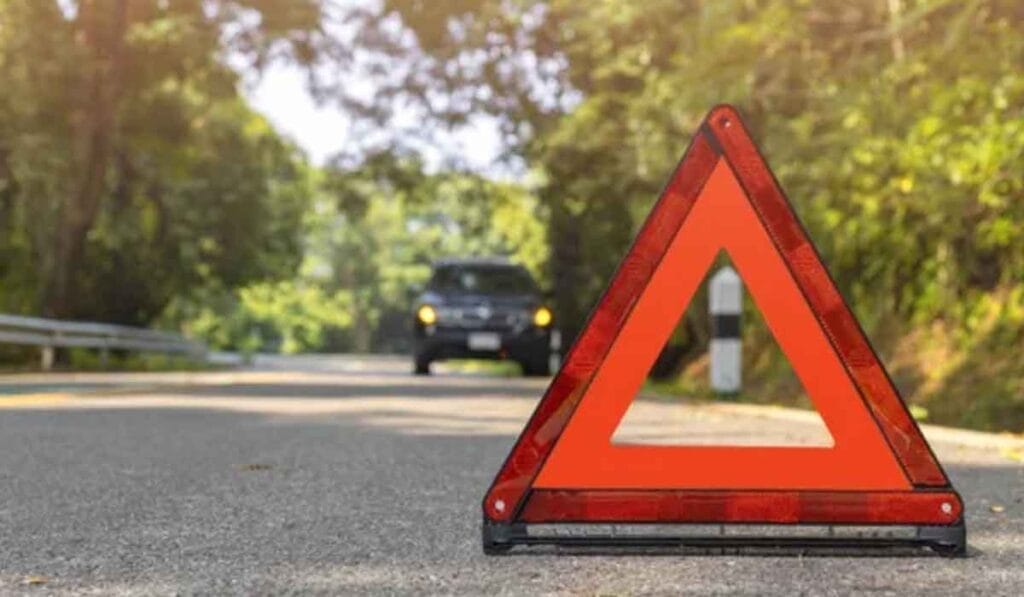
Turn on your hazard lights immediately after an auto accident.
This action alerts other drivers to slow down and navigate carefully around the incident site.
Grab any high-visibility jackets from your car’s emergency kit, so you’re easily seen by passing traffic and first responders.
Set up hazard signs if you have them in your vehicle.
Place these signs a fair distance away from the scene to give incoming traffic ample warning of potential danger ahead.
Keeping road safety at the forefront ensures not only your protection but also that of other accident victims and those coming to assist.
Assess the situation and call for emergency services

After an auto accident, quickly check how severe the situation is. Look for injuries or dangers like leaks.
If anyone is hurt or if there’s a risk of fire, call 911 right away.
Emergency medical technicians (EMTs) and paramedics need to come fast.
They can give first aid and take injured people to emergency rooms if needed.
Next, provide clear details about the location and what happened to the dispatcher.
Use landmarks if you’re unsure of your exact location.
Stay calm and listen carefully to instructions from emergency services on the phone.
They might guide you on how to help until professionals arrive with medical equipment, including first aid kits and possibly a stretcher for serious cases like spinal injuries or unconscious victims needing urgent care.
Basic First Aid for Auto Accident Injuries
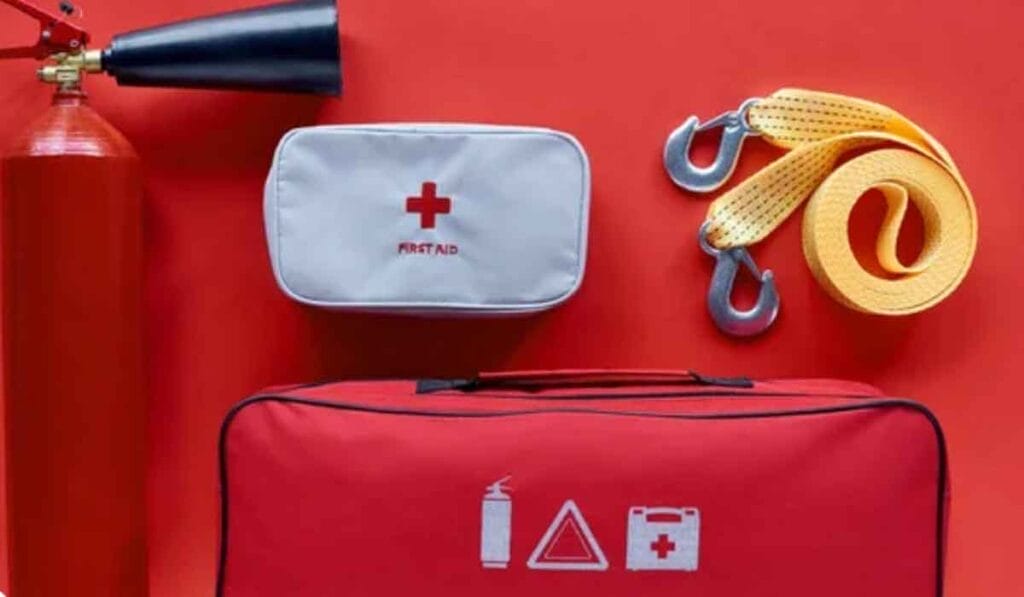
Knowing how to handle basic first aid for auto accident injuries can be a game-changer.
It helps control the situation until professional help arrives.
For instance, managing minor cuts involves cleaning the wound gently with soap and water, then covering it with a clean bandage.
If someone suffers from whiplash — a common neck injury in car crashes — keeping their neck stable is crucial.
Dealing with bone breaks or strains might need immobilization using makeshift splints, but only if you know how and emergency services are not immediately available.
Remember, your actions could prevent injuries from getting worse.
Always ensure you’re equipped with the right knowledge and tools like sterile gauze pads and protective gloves; these essentials turn ordinary people into lifesavers at crash scenes.
How to handle cuts and scrapes
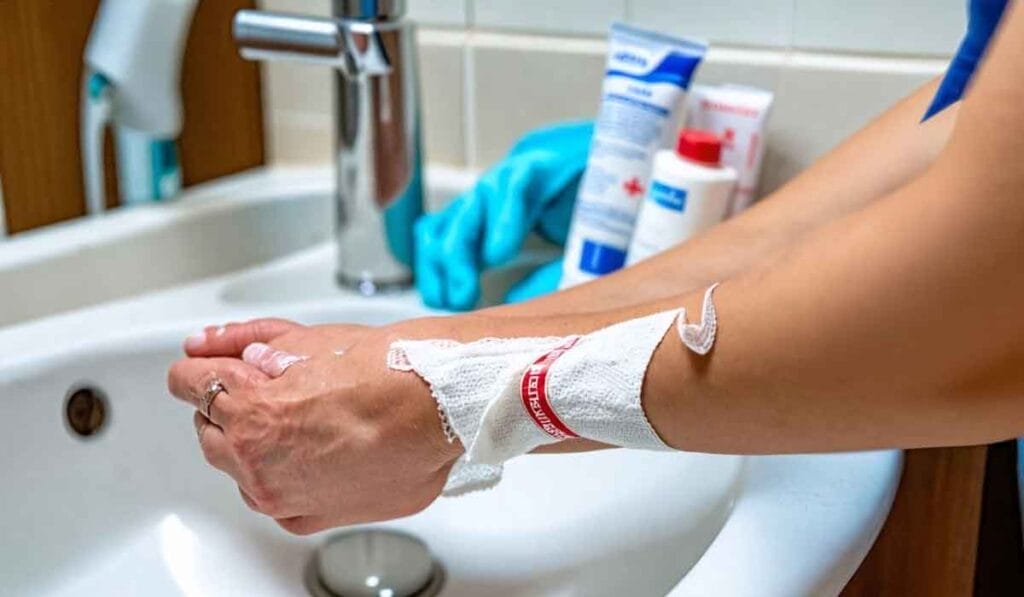
Clean the wound right away to fend off infection.
Use cool, running water and mild soap to gently wash around the injury.
Don’t scrub hard, as this can cause more pain or bleeding.
After cleaning, pat the area dry with a sterile gauze pad or clean cloth.
Apply an antibiotic ointment if you have one.
This helps prevent infections and keeps the wound moist for better healing.
Cover it up with a bandage or sterile gauze to protect it from bacteria and dirt.
Change the dressing daily or whenever it gets dirty or wet to promote fast healing and avoid infection risk.
If you see signs of infection like increased redness, swelling, warmth, or pus, seek medical attention promptly – these are signals that your body is fighting hard against invading germs and might need a bit more help than first aid alone can provide.
Managing whiplash injuries
Keep the neck still immediately after a car accident if you suspect whiplash.
Use a soft collar or, in emergency situations, improvised support to immobilize the neck.
This helps prevent further injury until professional medical help arrives.
Pain management is essential—over-the-counter pain relievers can lessen discomfort.
Seek chiropractic care or physical therapy promptly.
These professionals specialize in managing injuries from auto accidents, including whiplash.
They offer treatments that encourage healing and reduce long-term impact.
Remembering to stay active with gentle neck exercises suggested by healthcare providers also speeds up recovery.
Dealing with fractures and sprains
Handling broken bones and sprains can be critical after a car accident.
First, check if the injured person can move without pain; this will help you know if it’s a severe injury.
For suspected fractures, immobilize the area using whatever you have—like boards or magazines—as splints.
Secure them with bandages but don’t tie too tight. If an arm is hurt, use a scarf as a sling to keep it elevated.
For sprains, remember R.I.C.E: Rest the injured part to avoid more damage.
Ice the area for 20 minutes every couple of hours to reduce swelling.
Compress gently with bandages—not too snugly—to provide support.
Elevate the limb higher than the heart when possible. This method reduces pain and swelling effectively until professional medical help arrives.
Always call for emergency aid if there’s uncertainty about the severity of the injuries or how to treat them safely at home before help arrives.
Special Considerations
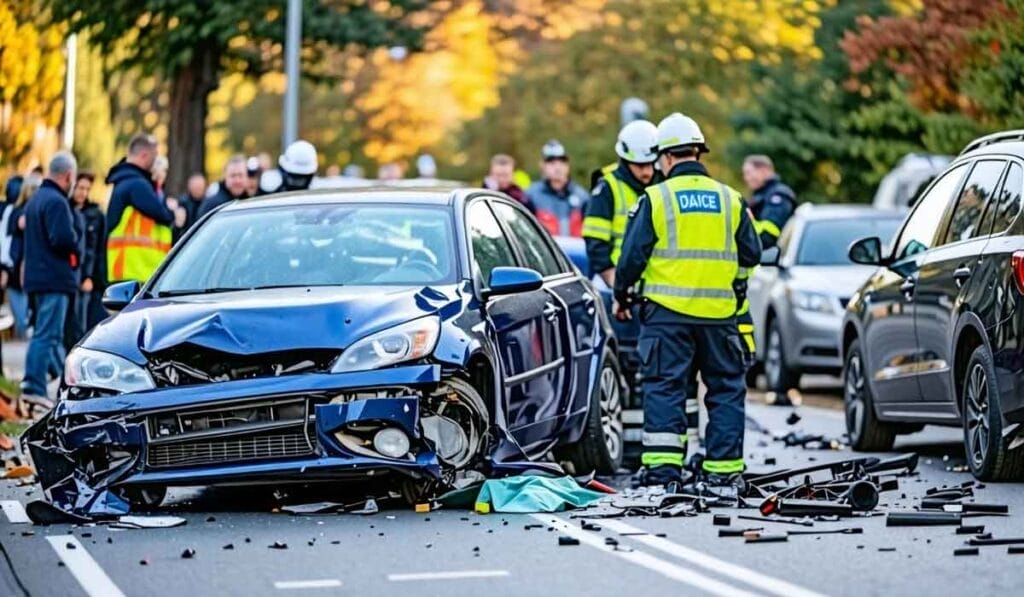
Dealing with shock and head traumas needs extra care after a car crash. Learn how to keep victims safe until help arrives.
First aid for shock in accident victims
First aid for shock in accident victims is crucial and can save lives.
If you find someone in shock after a car collision, start by laying them down and lifting their legs higher than their heart if possible.
This position helps blood flow to the most vital organs.
Cover them with a blanket to keep warm because shock can make them feel cold.
Always reassure them calmly as fear can worsen their condition.
Check for any signs of breathing difficulties, severe bleeding, or other injuries that require immediate attention.
Use your first aid kit; apply pressure to stop bleeding with clean cloths from it if needed.
Call ambulance services right away – quick medical response is essential.
Keep talking to the victim until help arrives, offering words of comfort and ensuring they know help is on the way.
These actions are key steps in managing motor-vehicle crash victims showing signs of traumatic stress.
Handling head injuries
Check the injured person carefully if you suspect a head injury.
Look for signs of traumatic brain injuries (TBIs), such as confusion, headache, dizziness, or clear fluids leaking from the nose or ears.
These symptoms could indicate serious issues like concussion or internal bleeding.
It’s crucial not to move someone with potential head trauma unless it’s absolutely necessary to prevent further harm.
Provide support and keep them still. If they’re conscious, encourage them to remain calm and still until help arrives.
Avoid giving food or water since it could complicate their condition if surgery is needed later on.
Covering them lightly can help maintain body warmth but be gentle around their head and neck area.
Immediate action and proper response are key in handling head injuries effectively.
When to Move an Injured Person
Deciding when to move an injured person is a key step. Use guidelines for safe movement to help them without causing more harm.
Guidelines for safe movement
Check the injured person for responsiveness and severe bleeding before thinking about moving them.
If they’re unconscious or have serious injuries, wait for emergency services to arrive.
Moving someone incorrectly can make spinal injuries worse.
Use your best judgment.
Only move them if there’s an immediate danger, like a fire or risk of another vehicle accident.
If you must move someone, keep their back and neck as straight as possible.
Slide your hands under their shoulders and hips carefully to shift them away from danger. Always aim to drag, rather than lift, to prevent further harm.
This method helps protect against worsening a spinal injury.
Remember, safety comes first—for both you and the injured person during these critical moments after an auto accident.
Legal and Safety Obligations
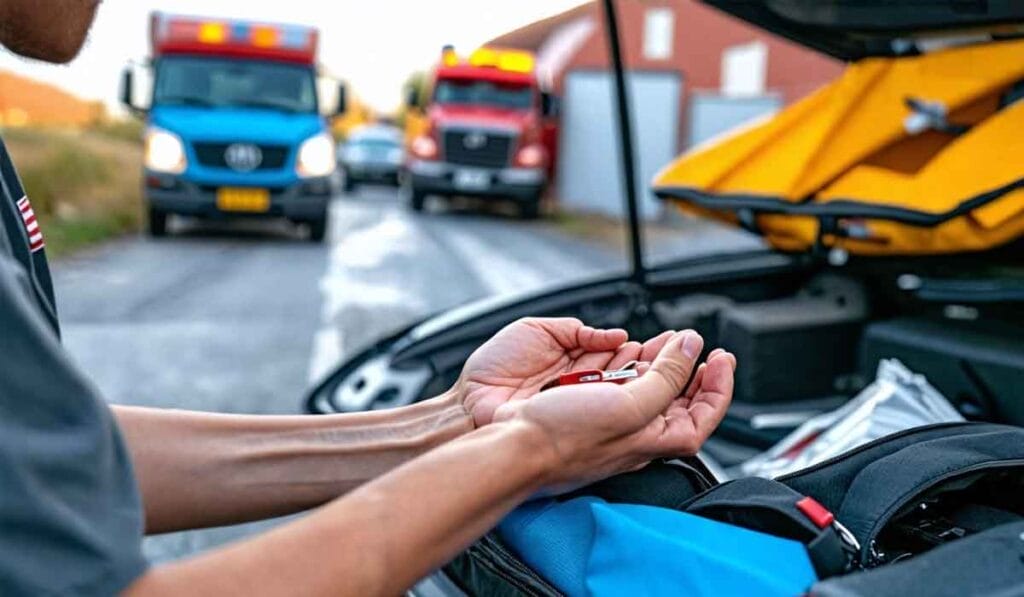
Understanding your legal and safety duties after a car crash is crucial. Always inform the authorities and capture photos for insurance matters. Additionally, exchange contact and insurance information with the other parties involved in the accident. Seek medical attention if necessary and gather any witness statements. It’s also important to seek car accident insurance claim advice from a legal professional to ensure you are properly compensated for any damages or injuries sustained.
Informing the police
After an auto accident, it’s crucial to call the police.
This step is not just about following legal procedures; it’s essential for your safety and for documenting the incident.
The officers will create a traffic crash report, which plays a vital role in insurance claims and any legal actions that might follow.
They gather evidence, take statements from everyone involved, and assess traffic infractions or violations.
The presence of law enforcement at the scene adds an official record to your case.
Make sure to exchange contact information with the other driver, including driver’s license numbers and insurance details.
Also, if there are witnesses, get their information too.
Having these details strengthens your position when dealing with car accidents’ aftermaths—whether it’s for national highway traffic administration records or court cases.
Documenting the accident scene for insurance claims
Taking photos of the accident scene is crucial.
Snap pictures from different angles to capture all damages to your vehicle and any other cars involved.
Include shots of road signs, skid marks, and traffic signals that could show how the incident happened.
These images serve as solid evidence for insurance claims and can help speed up the process.
Write down everything while it’s fresh in your memory. Note the time, date, and location of the crash.
Collect names, contact information, and insurance details from others involved.
If there are witnesses, get their accounts too; they might offer valuable insights into what occurred.
Keeping a detailed record supports your claim, making it easier for your insurance company to understand the event’s specifics.
Conclusion
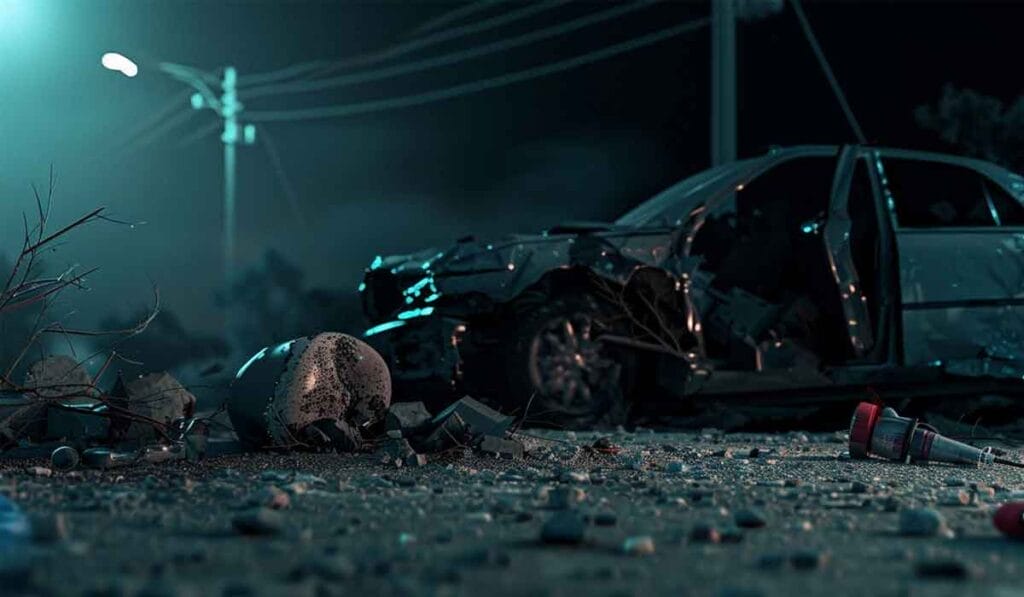
Mastering first aid for auto accident injuries can save lives. It makes you ready to act fast in an emergency.
Think about how knowing what to do with cuts, whiplash, or fractures could help someone in need.
Remember, your quick thinking and actions might prevent a situation from getting worse.
Be the person who steps up with confidence during accidents – it could really make a difference.
FAQs
1. What are the essential first-aid steps to take after an auto accident?
After ensuring your safety and calling for help, administer cardiopulmonary resuscitation (CPR) if necessary, treat open wounds with a clean bandage or cloth, apply Neosporin to minor cuts and bruises, place victims in the recovery position to maintain their airway.
2. How can I prepare for potential road traffic accidents?
Accident preparedness involves having a well-stocked first aid kit, understanding good samaritan laws which protect first aiders from liability during emergencies, keeping an up-to-date first aid manual handy and wearing seat belts or motorcycle helmets as appropriate.
3. Why is it important to follow traffic safety measures like wearing seat belts or using child car seats?
Traffic safety measures reduce injuries during motor vehicle crashes by preventing blunt force trauma. According to the National Highway Traffic Safety Administration (NHTSA), they significantly decrease motor-vehicle deaths and traffic fatalities.
4. Can learning about First Aid benefit me even if I’m not involved in frequent driving activities such as public transport users or cyclists?
Absolutely! Accidents can occur anywhere – knowing how to respond effectively could make a difference between life and death in any traumatic event whether on foot, cycling or aboard public transport.
5. Is there any legal protection for people who provide first aid at accident scenes?
Yes! Good Samaritan Laws offer legal protection to those assisting others during medical emergencies including road traffic accidents.
6.What should be done immediately following an accident involving burn injuries?
Firstly ensure your own safety then call emergency services right away. While waiting for professional help, don’t touch the burn directly but try covering it with a cool moist sterile bandage; never use ice on burns as it may cause further damage.

